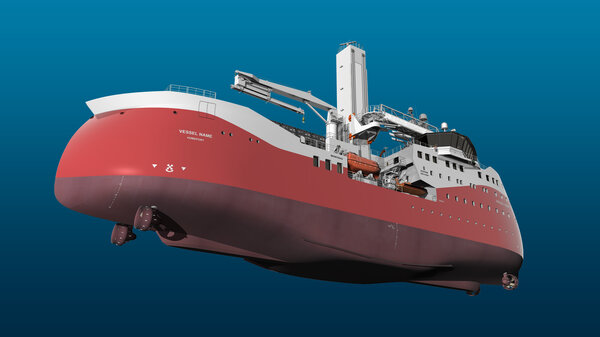The TWIN X-STERN design is distinguished by its dual stern underwater configuration, equipped with main propellers at each end. This unique setup enhances manoeuvrability and motion, leading to improved fuel efficiency - a critical factor in the drive towards more sustainable and efficient maritime operations.

Olympic Boreas sea trial - First real-scale test
The recent sea trials of the Olympic Boreas marked the first real-scale, live environment test of the TWIN X-STERN 's unique characteristics, confirming its anticipated superior properties.

Versatility across vessel operations and sizes
The ten TWIN X-STERN new builds currently under construction are exclusively designed as Construction Service Operation Vessels (CSOVs) for the offshore energy industry. However, the TWIN X-STERN's functionality extends beyond these specific operations. The principles and benefits behind the TWIN X-STERN, such as exceptional manoeuvrability, agility, and flexibility, apply to various vessel types and sizes.
To date, all contracted TWIN X-STERN vessels range from 80 to 90 metres in length. However, the TWIN X-STERN solution is not confined by length. Its benefits are evident across a broad spectrum of vessel lengths, from the 69m long Service Operation Vessel (SOV) ULSTEIN SX234 to the 170m long Cable Laying Vessel (CLV) ULSTEIN SX225.
Expanding operational scope
The TWIN X-STERN concept originated within the walk-to-work market, where its first application was identified, and the challenges it solves were recognised. For walk-to-work operations, the ability to transit forward or backward offers significant time efficiency.
We anticipate that subsea operations and cable laying will be the next sectors to reap the benefits of these versatile vessels. The TWIN X-STERN enhances the ability to operate with the stern or bow facing the weather, eliminating the need for the vessel to reorient if sea state conditions change. This increases the operational window, a vital feature for other energy vessels, such as subsea and cable-laying vessels. Cable-laying vessels spend a significant amount of time at sea and have limited flexibility to adjust their heading towards the weather, as the final position of the cable determines the heading. The TWIN X-STERN's seakeeping performance will be instrumental in future cable lay and subsea operations, enabling safer and more effective operations.
Manoeuvrability and workability are key to the vessel’s competitiveness and operational efficiency in all three segments: walk-to-work, cable lay, and subsea.
Introducing the TWIN X-STERN to new market segments
The original first sketch of the ULSTEIN TWIN X-STERN is in the middle, surrounded by recent applications—a perfect example of incremental innovation.

Flexible layout for enhanced cargo capacity
The size of the deck area is a critical factor in determining the amount of cargo that cable-laying, pipe-laying, and subsea vessels can carry on deck. In such vessels, a rounded stern might pose a limitation. However, it is possible to compromise on the shape of the stern above the waterline and retain the squared shape of the deck to maximize cargo capacity.
Global construction and operations
Six of the CSOV TWIN X-STERN vessels will be constructed at Ulstein Verft, with an additional four being built at an external yard. These vessels, designed to endure harsh sea conditions, are the brainchild of Ulstein Design & Solutions AS, a company acclaimed for innovative and resilient vessel designs.
The TWIN X-STERN is engineered for all seas. While the initial units are taking shape in Europe, Ulstein's ship designs extend to the Asian market, where Ulstein Design & Solutions has facilitated the construction of a multitude of vessels.





